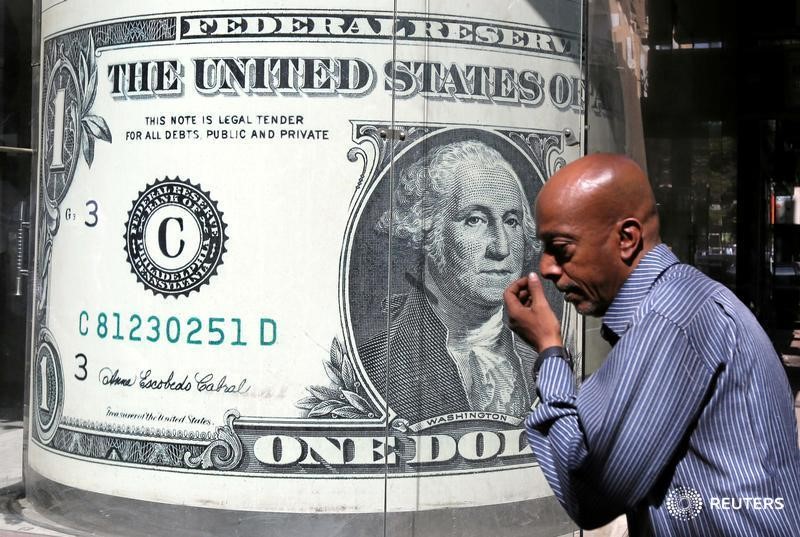Gold prices edge lower; heading for weekly losses ahead of U.S.-Russia talks
Investing.com - The U.S. dollar steadied Thursday, remaining near multi-year lows amid caution ahead of the release of the widely-watched U.S. monthly jobs report, which could influence the Federal Reserve’s next move.
At 04:00 ET (08:00 GMT), the Dollar Index, which tracks the greenback against a basket of six other currencies, traded largely unchanged at 96.420, remaining close to over three-year lows, and on course for a 0.5% drop for the week.
Dollar awaits payrolls release
The U.S. currency has barely moved so far Thursday despite President Donald Trump stating the U.S. had reached a trade agreement with Vietnam, and Republicans in the House of Representatives moving closer toward advancing Trump’s "big, beautiful bill" on tax cuts.
This is because the focus is well and truly on the release of the monthly jobs report later in the session, given this could make or break the case for a July rate cut by the Federal Reserve.
Economists anticipate that a total of 110,000 jobs were added during the month, inching down from 139,000 in May, but the possibility of a weaker number exists given Wednesday’s private sector payrolls report recorded the first fall in over two years.
Along with signs of relatively benign inflationary pressures, investors have been keeping tabs on the trajectory of the American labor market. Corralling price growth and working to ensure maximum employment remain two of the central mandates of a Federal Reserve which has taken a cautious approach to policy decisions in recent months.
“Chair Powell, leading the camp for the Fed to keep rates on hold, argues that sticky inflation and a solid labor market mean that the policy rate should be kept mildly restrictive at 4.25%-4.50% for the time being,” said analysts at ING, in a note.
“Clearly, any downside surprise in the jobs report would weaken his position and allow the market to push on with pricing a rate cut at the July meeting. Currently, the market attaches a 26% probability to that outcome.”
Sterling bounces after sharp drop
In Europe, EUR/USD gained 0.1% to 1.1806, near the September 2021 top it hit earlier this week.
There are services PMI data to digest from the eurozone as a whole later in the session, but it’s likely that the U.S. payrolls release will drive sentiment during the session.
The European Central Bank cut rates for the eighth time in a year last month, bringing its widely-watched deposit rate down to 2%, while indicating it would likely pause at its next meeting.
And the ECB should keep its deposit rate at the current level unless new shocks materially change the inflation outlook, Alfred Kammer, head of the IMF’s European Department, said on Wednesday.
"Risks around eurozone inflation are two-sided," Kammer said on the sidelines of the ECB Forum on Central Banking in Sintra, Portugal. "This is why we think the ECB should stay the course and not move away from a 2% deposit rate unless there is a shock that materially changes the inflation outlook. Right now we don’t see anything of such magnitude."
GBP/USD gained 0.2% to 1.3665, bouncing to a degree after falling nearly 1% in the previous trading session on concerns about Britain’s finances after the government backed down on welfare reforms.
“The markets bought into the view that the fiscally responsible Chancellor, Rachel Reeves, could be forced to resign,” said ING. “In retrospect, perhaps PM Keir Starmer merely misjudged the mood of the House of Commons (and the markets) by not backing her straight away (he has now).”
“Clearly, the UK has some significant fiscal challenges which will come to the fore ahead of November’s budget.”
Limited moves in Asia
In Asia, USD/JPY traded 0.1% higher to 143.88, barely moved as traders remained on edge over progress towards more trade deals with the United States.
USD/CNY slipped marginally lower to 7.1621, after a private purchasing managers index reading on the services sector read softer-than-expected for June, although it still grew for a thirtieth consecutive month.
The yuan also showed little reaction to statements from major chip design firms that the U.S. had relaxed some restrictions on sales to China, effective immediately.
The move marked an improvement in Sino-U.S. trade relations, and comes just weeks after the two agreed to a framework trade deal.
